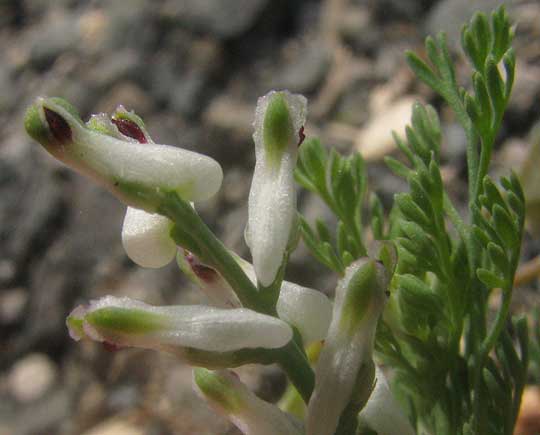Excerpts from Jim Conrad's
Naturalist Newsletter
from the April 27, 2014 Newsletter issued from the Frio Canyon Nature Education Center in the valley of the Dry Frio River in northern Uvalde County, southwestern Texas, on the southern border of the Edwards Plateau; elevation ~1750m (~5750 ft); N29.62°, W99.86°; USA
DENSE-FLOWERED FUMATORY
Beside the gravel road leading into Cooks Slough Refuge on Uvalde's south side a ferny-leafed little herb with its stems twisted as if deformed by herbicides caught my attention. For one thing, each small, bilaterally symmetrical flower bore a nectar-bearing
"spur" that projected behind it, making the blossom very similar to what wildflower lovers know as Corydalis. However, the Corydalis species I know bear yellow flowers, while these were white, with a dark purple spot. You can see the twisted plant below:

A close-up of its unusual flowers is shown below:

Unable to find any Corydalis species looking like this, in the online Flora of North America I went to the Fumaria Family page, for that's the family the Flora says Corydalis belongs to, and keyed out the plant. The genus I came up with was the fumatory genus Fumaria, native to the old world, with no species native to the Americas.
Our introduced little fumatory seems to be FUMARIA DENSIFLORA, sometimes called the Dense-flowered Fumitory, and in the US so far it seems to have invaded only a few counties in Texas. You can see its present known distribution in the US -- not yet shown as occurring in our Uvalde County -- at http://bonap.net/MapGallery/County/Fumaria%20densiflora.png.
Dense-flowered Fumitory is native to the Mediterranean Region, including western Asia, so it must find Texas's dry heat to its liking.
Though the Flora of North America places fumatories in their own family, the Fumatory Family, the Fumariaceae, some experts assign them to the Poppy Family, the Papaveraceae, and that reminds us that in the Old World fumatory species often were regarded as medicinal plants. Mrs. M. Grieve, in her venerable A Modern Herbal, is in her usual confident and somewhat indecipherable form when she says of fumatories in general that they provide... "A weak tonic, slightly diaphoretic, diuretic, and aperient; valuable in all visceral obstructions, particularly those of the liver, in scorbutic affections, and in troublesome eruptive diseases, even those of the leprous order."